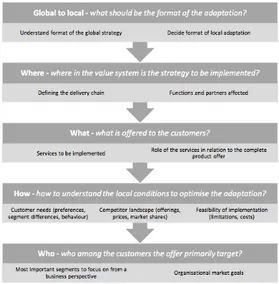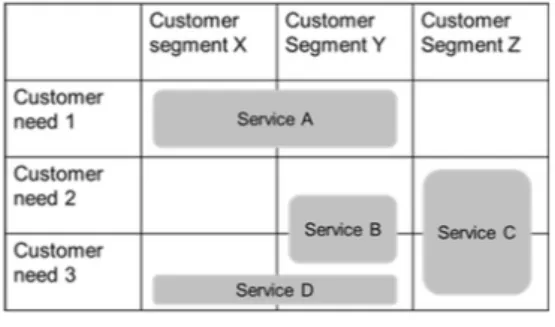Going from Global to Local
Adapting the service offer in the Delivery Chain
Johan Ekman Malin Ekman
Department of Production Management Faculty of Engineering (LTH), Lund University
January 2017
This article is based on a master’s thesis produced at Company X during the autumn of 2016. Through a case study of a local market organisation in a multinational
manufacturing company, the process of adapting a Global Strategy regarding services in the delivery chain to local market organisations to gain competitive advantage was analysed. This was done by developing a competitive and customer
oriented portfolio of logistics services for the Swedish market organisation.
Introduction and Background
Many global companies within the manufacturing industry face several challenges in adapting to today’s rapidly changing business
environment. One way for
manufacturing companies to gain competitive advantage is to
complement the product offering with surrounding services that deliver superior value to the customer. (Fischer, Gebauer, & Fleisch, 2012) Further, all companies present in the international business environment need to find a balance between global and local aspects in how they
formulate strategy and run their business When analysing how to balance global and local
aspects, companies need to consider the benefits of global-‐scale opportunities and need for national responsiveness
.
This also applies to sub-‐strategies such as a company’s logistics strategy. (Lynch, 2009)The logistics function of manufacturing companies has traditionally been considered “necessary evil”. However, as the manufacturing industry is becoming more service-‐oriented, services in the delivery chain have been identified to increase customer value (Huttu & Martinsuo, 2015). Companies can extend their product offering through services related to logistics,
transportation and delivery. Kitting, labelling, express deliveries and online tracking are examples of these kinds of solutions (Gebauer, Fleisch, & Friedli, 2005).
Global manufacturing companies stand before the challenge of developing an offering of services in the delivery chain to surround their products. The service offer needs to add value to the customer, create a competitive advantage and be
adapted after local conditions for each market where the company is present.
Purpose
The purpose of this study is to describe and analyse how a market organisation within a multinational company can develop a competitive and customer-‐oriented service offer in the delivery chain, through modifying and adapting global strategy to local conditions to gain competitive advantage.
As the purpose indicates the study is limited to one market organization – Sweden. Further, services in other part of the value chain, value added services are delimited. Detailed capacity and feasibility assessment, competitor analysis as well as planning an implementation of the service offer are not in scope of the thesis.
Methodology
The research was conducted through a case study at Company X to gain insight to how Global Strategy regarding services in the delivery chain, logistics services, is adapted to a local market organisation. In the case study both quantitative and qualitative data was used. Interviews with stakeholders in the global-‐ and Swedish market organisation (account managers, logistics-‐ and marketing staff), customers and transporters to get information on the company’s’ Global strategy and customer’s needs and preferences. Internal company documents were also used for this purpose. Surveys were used to get a deeper understanding of the local customer needs and preferences regarding logistics services. A
literature study was conducted to give the authors a deeper knowledge within the investigated field.
Theory
The theoretical framework that was set up in this master thesis aimed to investigate three aspects – Where? What? How?
‘Where?’ relates to determining what
parts of an organisation is included in the delivery chain. By analysing Porters model of The Value System and The Generic Value Chain (Porter, 1985) and Tanner and Raymond’s model of Typical Distribution Channels
in Business-‐to-‐Business Markets
(Tanner & Raymond 2012) the Delivery
Chain was determined. Delivery is the
physical movement of products from the company ́s point of production until the customer and the Delivery Chain was determined to include the downstream activities in the firm’s value chain and the channel value chains, see coloured parts in Figure 1.
Figure 1 The Delivery Chain as defined from Porters model of the Value System
‘What?’ refers to understanding what
is being investigated i.e. logistics services. Kotler’s model Three Levels of
a Product (Jain, 2009) was applied to
understand logistics services the company offering in a larger perspective.
‘How?’ refers to the question of how to
understand the customers preferences and buying behaviour in regards to services in the delivery chain. Kotler’s model of Business buyer behaviour and
four questions of business buyer behaviour (Kotler et. al 1999) was
Conclusions
The previously presented areas of
Where? What? and How? generated a
recommended strategy regarding the service offering for Company X in Sweden.
Regarding the question Where? -‐ The
Delivery Chain of company X was
determined to include the regional warehouse and its entire operations – the warehousing staff, the picking and packing processes and the outbound logistics and shipping. It also includes the marketing & sales and customer service departments in Sweden. Finally, in relation to the channel value chains; Company X has a direct sales model which concluded the transporters be the last component of the Delivery Chain.
In terms of What? – what is to be analysed. Company X was found to have pre-‐determined nine advanced logistics services. It was concluded that it was only services that were not yet fully implemented on the Swedish market that were to be included in the strategy. Hence eight logistics services were identified to be analysed. Further, analysis of Company X’s complete product offering concluded logistics services to be at the third level of a product the augmented product, see Figure 2.
Developing a competitive offer of services in the delivery chain, in this case of the augmented product is a differentiation opportunity. However, it must not be forgotten that these solutions are not the core business and rather have the aim to support the fulfilment of goals and targets for the business as a whole. Advanced logistics were found to be can be an order winner, but is generally not an order qualifier and it was concluded that Company X develop its logistics service offer accordingly.
How? – understanding the customer
was approached in several steps. A broad picture of the customer preferences regarding logistics services was created through surveys to customers and account managers. Logistics services were determined to target either one or both determined customer segments Large and Small customers. Further they were found to target one or both customer needs areas Time and Convenience. A position map of the services could be made, see Figure 3.
Figure 3 Service position map -‐ customer need and segments
Analysis of customer buying behaviour showed no significant difference between customer segments other that Large customer tend to value
Convenience more in a buying decision
while Small customers value Time.
Figure 2 Company X complete product offer based on the model Three levels of a product (Jain 2009)
As the service offer in the delivery chain should be formed to support the core business, it should consequently target the most important customers for the core business. In the case of Company X these were the Large customers. Empirical data analysis showed that logistics services had a higher importance to larger
customers, Large customer generate a higher ROI and there are looking for partnerships which is in line with Company X Global Strategy.
The Service Position Map (Figure 3) was used to prioritise the logistics services to primarily focus on Large customers and cover both needs areas but slightly more focus on
Convenience. The results are
presented in figure 4.
Figure 4 Prioritisation of the services in the position map
Academic Contribution
There are two main contributions that this study leaves from an academic perspective.
The first is insights on the importance of, and process of understanding and specifying the questions Where?
What? and How? through the
presented theoretical framework when adapting strategy.
The second is insights regarding how Kotler’s model Three levels of a
product can be used to analyse
components of the augmented
product and how this knowledge
should be used to form an offer at this level that strengthens the core and actual product rather than sub-‐ optimising that particular product component.
Reflections
The study generated insights and recommendations for Company X. Further, a generalised model for Going
from Global to Local and developing a
competitive offer based on local conditions was developed, see Figure 5.
Figure 5 Generalised model of Going from Global to Local
After determining the format of the local strategy, addressing the questions Where? What? How? and determining focus customers a
competitive offer should be developed based on the strategy format, local conditions and focus customers. In terms of understanding How? – the local conditions three areas should be investigated: customer preferences, competitive landscape and feasibility of implementation. The two later were delimited from this study.
A general process was developed for understanding the customers in the local market (exemplified through services) that consists of several steps. First, a broad understanding of
customer should be determined. Next, relevant customer segments and needs should be determined. These can be used to make a Position Map, see Figure 6.
Figure 6 General Position Map
Next, customer buying behaviour for each segment should be understood. These results can be used as input when developing the local strategy to target focus customers.
Concluding Remarks
Services in the delivery chain is a way for multinational manufacturing companies to differentiate and should be included in the Global Strategy that is to be adapted to local markets. a local adaptation of a global strategy is an iterative process and companies must continuously monitor local market developments and adjust the local strategy accordingly. Also, global companies should leverage best practices from their respective market organisations globally.
If adapting the strategy as recommended, companies can develop a competitive service offer in the delivery chain both
in line with organisational goals and that is
tailored to respective local market conditions. By doing that they can achieve a global competitive advantage.
References
Fischer, T., Gebauer, H., & Fleisch, E.
(2012).Service Business Development:
Strategies for Value Creation in Manufacturing Firms. Retrieved
2015, from https://www-‐cambridge-‐ org.ludwig.lub.lu.se/core/books/servi ce-‐business-‐ development/FE1B605D59F1A9CB45 DBB4AA78D30CCF [20th September 2016]
Gebauer, H., Fleisch, E., & Friedli, T. (2005). Overcoming the Service Paradox in Manufacturing Companies. European
Management Journal, 23(1), 14-‐26.
Huttu, E., & Martinsuo, M. (2015).
Differentiation value through services in a manufacturer's delivery chain.
The Service Industries Journal, 35(14),
763-‐882.
Jain, A. (2009). Principles of Marketing. New Delhi: V.K Enterprises.
Kotler, P., Armstrong, G., Saunders, J., & Wong, V. (1999). Principles of Marketing (2nd Edition ed.). New Jersey, USA: Prentice Hall Inc.
Porter, M. E. (1985). The Competitive
Advantage: Creating and Sustaining Superior Performance (1:a upplagan
ed.). New York: Free Press.
Tanner, J., & Raymond, M. (2012). Principles
of Marketing, v. 2.0 (2:a upplagan
ed.). Flat World Knowledge, Inc.


